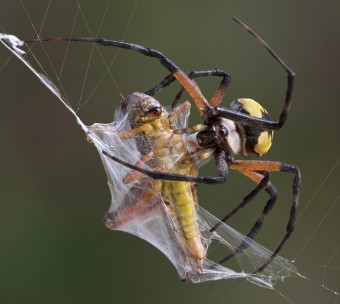Spiders and Webs – Why Don’t They Get Stuck?
 Moths, beetles and flies all get caught in spider webs, but you almost never see a spider unable to extricate herself from one. Here’s why.
Moths, beetles and flies all get caught in spider webs, but you almost never see a spider unable to extricate herself from one. Here’s why.
The Web
When a spider makes an orb web, each line is actually comprised of at least two or more threads, and in fact, the supporting threads, radiating spokes and hub are all made from silk that is not sticky.
On the other hand, the strands that comprise the “net” part of the web, those that usually trap unwary insects, are covered with glue. The fact that the spider is able to navigate these sticky threads as effectively as it does has to do with a couple of unique properties on her legs.
Spider Legs
An oily substance apparently covers spider legs and helps keep the glue from sticking. Pursuant to a study published in 2011 in the journal Naturwissenschaften, arachnologists Eberhard and Briceno washed the legs of spiders and found that after they were clean, the legs were much more likely to adhere to sticky threads.
In addition, Eberhard and Briceno also noted that the spider’s gait seemed specially designed, such that it “reduced the area of contact between the sticky droplets and the setae [spiny leg hairs].” This, combined with the fact that the thread touched many (rather than only a few) branching hairs, made it very unlikely that any glue would slide all the way down the hairs to make contact with the main part of the leg – which would have made permanent adherence more likely.
Furthermore, the spider has a unique way of grasping sticky threat, using a third claw that allows it to shake itself free from the glue. As it walks along sticky silk, the spider grasps the thread with its third claw and presses the silk into its spiny hairs, which are somewhat elastic and, therefore, bend back under the pressure.
As the spider moves down the thread, it releases portions of it with its third claw, freeing the hairs, which thenrebound outward, effectively flinging the sticky thread away from its leg.
Others’ Webs
Although rare (since most webs are designed to catch flying insects not crawling ones), spiders will occasionally get caught in their competitors’ webs. Even then, though, many times they are able to extricate themselves.
However, some spiders are known to use their competitors’ webs against them. Some of these belong to the genus, Portia. The Portias prey on their cousins by pretending to be either a captured victim or a courting male of the same species.
Able to jump in and out of a web, the Portia coordinates its leap onto the web with a breeze, so that any vibrations caused by the jump are camouflaged by those caused by the wind. Crafty, Portias change their tactics depending on the species being hunted, and even successfully kill (and eat) other aggressive spiders.
If you liked this article and the Bonus Spider Facts below, you might also enjoy:
- Why Geckos’ Feet Can Stick to Just About Anything
- Why Mosquito Bites Itch
- Do Earwigs Really Lay Eggs in Your Ears?
- Where Do Insects Go in Winter?
- “Daddy Long Legs” Are Not the Most Poisonous Spider
Bonus Spider Facts
- There are 35,000 named species of spiders, including 3,000 in North America, although scientists believe there are many more that have yet to be identified.
- Three kinds of venomous spiders are found in the US: hobo, black widow and brown recluse. Black widows are most common in the South and West, but may be found throughout the nation. The brown recluse is found mostly in the Midwest and South, and interestingly can only bite a human if it is somehow caught against the skin. The hobo spider is found in the Pacific Northwest.
- In 2011, a Colorado man died after receiving 19 bites from a (or several) black widow spider(s), and in 2014, a Florida man died from complications from a brown recluse spider bite. Authorities say deaths from spider bites are exceedingly rare, however.
- Australia has over 50 species of venomous spiders, the bites of two of which, the red-back and Sydney funnel-spider, may even be fatal for people.
- The world’s largest spider is the Goliath Bird-Eating tarantula (GBET), which can reach up to one foot in length. A resident of South America, this predator sneaks up on its victims, incapacitating them with the venom from its one-inch long fangs and, in fact, does not even need to weave a web. In addition to birds, the GBET also eats lizards, snakes, bats and frogs. Since it has no molars, rather than chew its meals, the GBET injects the victim with a juice that breaks down tissues so they can be “slurped up.” Although not fatal for humans, its bit will cause nausea, sweating and severe pain.
- The biggest webs made by individual spiders are those of the Darwin’s bark spider of Madagascar. With the largest found spanning 80 feet and a river, these webs are made of the strongest biological material known in the world.
- In August 2007, one of the largest communal webs ever seen was made by a group of Guatemalan Long-jawed Spiders in an East Texas state park. Although normally cannibals, due to heavy rains and an unusually high amount of prey, the spiders chose to “live in harmony.” Altogether, the web spanned 180 meters, and, according to researchers, 12 families and 250 individuals were living together, “fat and happy so to speak.”
| Share the Knowledge! |
|





One comment